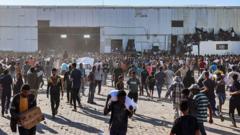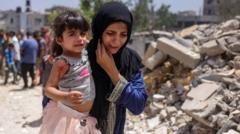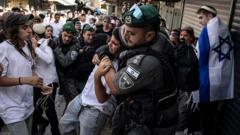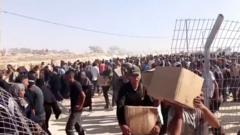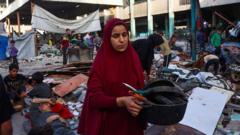The UN Human Rights Office has confirmed that gunfire from Israeli forces left dozens injured during a chaotic aid distribution event in Gaza, with conflicting accounts from Israeli officials and local health authorities regarding the circumstances of the incident.
Violence Erupts at Gaza Aid Distribution, Injuries Reported Amid Chaos
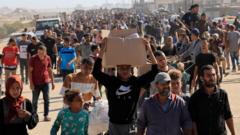
Violence Erupts at Gaza Aid Distribution, Injuries Reported Amid Chaos
UN reports on the chaos at a Gaza aid site, where gunfire broke out, leaving numerous injured as crowds surged for assistance facilitated by a US-backed group.
In a troubling incident reported by the UN Human Rights Office, it was noted that approximately 47 individuals were injured in Gaza on Tuesday as overwhelming crowds surged towards an aid distribution center operated by a controversial organization supported by the US and Israel. A senior UN official indicated that many injuries were the result of gunfire directed at the crowd and emphasized that "it was shooting from the IDF [Israel Defense Forces]." Meanwhile, Gaza's health ministry reported one fatality and 48 injuries resulting from the incident.
The IDF responded by stating that it was investigating the reports but claimed that troops had only fired “warning shots” into the air near the distribution site and did not fire at the people present. The aid distributed by the Gaza Humanitarian Foundation (GHF) has sparked contention, as it bypasses the UN and utilizes US security contractors for delivery, with the UN deeming such practices as both unethical and impractical.
Desperation drove thousands of Palestinians to the GHF center in Rafah, which operates under Israeli military oversight. Observations from the scene depicted chaotic conditions as families, including men, women, and children, rushed to claim aid, surmounting barriers and ignoring warnings as what appeared to be gunfire echoed. Reports from a UN official, Ajith Sunghay, indicated that they were attempting to confirm the severity of the injuries incurred during this turmoil, disclosing that many people were fearful of making the journey to the aid center due to security risks, including the potential for detention by Israeli forces.
In defense of the GHF, officials asserted that measures were implemented to ensure safe aid distribution. However, critics have denounced the organization's approach, citing the risks posed to civilians as they navigate dangerous situations in pursuit of basic necessities. The conflicting narratives of the IDF and Gaza health officials reflect the ongoing tension in the region regarding aid distribution amidst the significant humanitarian crisis exacerbated by the ongoing Israeli blockade.
Israeli leadership, including Prime Minister Benjamin Netanyahu, has acknowledged challenges at the GHF distribution site, yet they maintain that their controlled aid delivery system remains necessary to thwart Hamas from diverting resources. As the humanitarian situation in Gaza continues to deteriorate, established aid agencies argue for collaboration, promoting principles of neutrality and impartiality in delivering assistance while tackling rampant looting issues.
Escalation of violence in Gaza since October 2023 — following Hamas’ attacks that claimed over 1,200 lives in Israel — has led to grave consequences, with Gaza's health ministry reporting over 54,000 deaths since the outbreak of hostilities. Amid such a dire circumstance, the urgency for effective and safe aid distribution remains paramount.
The IDF responded by stating that it was investigating the reports but claimed that troops had only fired “warning shots” into the air near the distribution site and did not fire at the people present. The aid distributed by the Gaza Humanitarian Foundation (GHF) has sparked contention, as it bypasses the UN and utilizes US security contractors for delivery, with the UN deeming such practices as both unethical and impractical.
Desperation drove thousands of Palestinians to the GHF center in Rafah, which operates under Israeli military oversight. Observations from the scene depicted chaotic conditions as families, including men, women, and children, rushed to claim aid, surmounting barriers and ignoring warnings as what appeared to be gunfire echoed. Reports from a UN official, Ajith Sunghay, indicated that they were attempting to confirm the severity of the injuries incurred during this turmoil, disclosing that many people were fearful of making the journey to the aid center due to security risks, including the potential for detention by Israeli forces.
In defense of the GHF, officials asserted that measures were implemented to ensure safe aid distribution. However, critics have denounced the organization's approach, citing the risks posed to civilians as they navigate dangerous situations in pursuit of basic necessities. The conflicting narratives of the IDF and Gaza health officials reflect the ongoing tension in the region regarding aid distribution amidst the significant humanitarian crisis exacerbated by the ongoing Israeli blockade.
Israeli leadership, including Prime Minister Benjamin Netanyahu, has acknowledged challenges at the GHF distribution site, yet they maintain that their controlled aid delivery system remains necessary to thwart Hamas from diverting resources. As the humanitarian situation in Gaza continues to deteriorate, established aid agencies argue for collaboration, promoting principles of neutrality and impartiality in delivering assistance while tackling rampant looting issues.
Escalation of violence in Gaza since October 2023 — following Hamas’ attacks that claimed over 1,200 lives in Israel — has led to grave consequences, with Gaza's health ministry reporting over 54,000 deaths since the outbreak of hostilities. Amid such a dire circumstance, the urgency for effective and safe aid distribution remains paramount.


